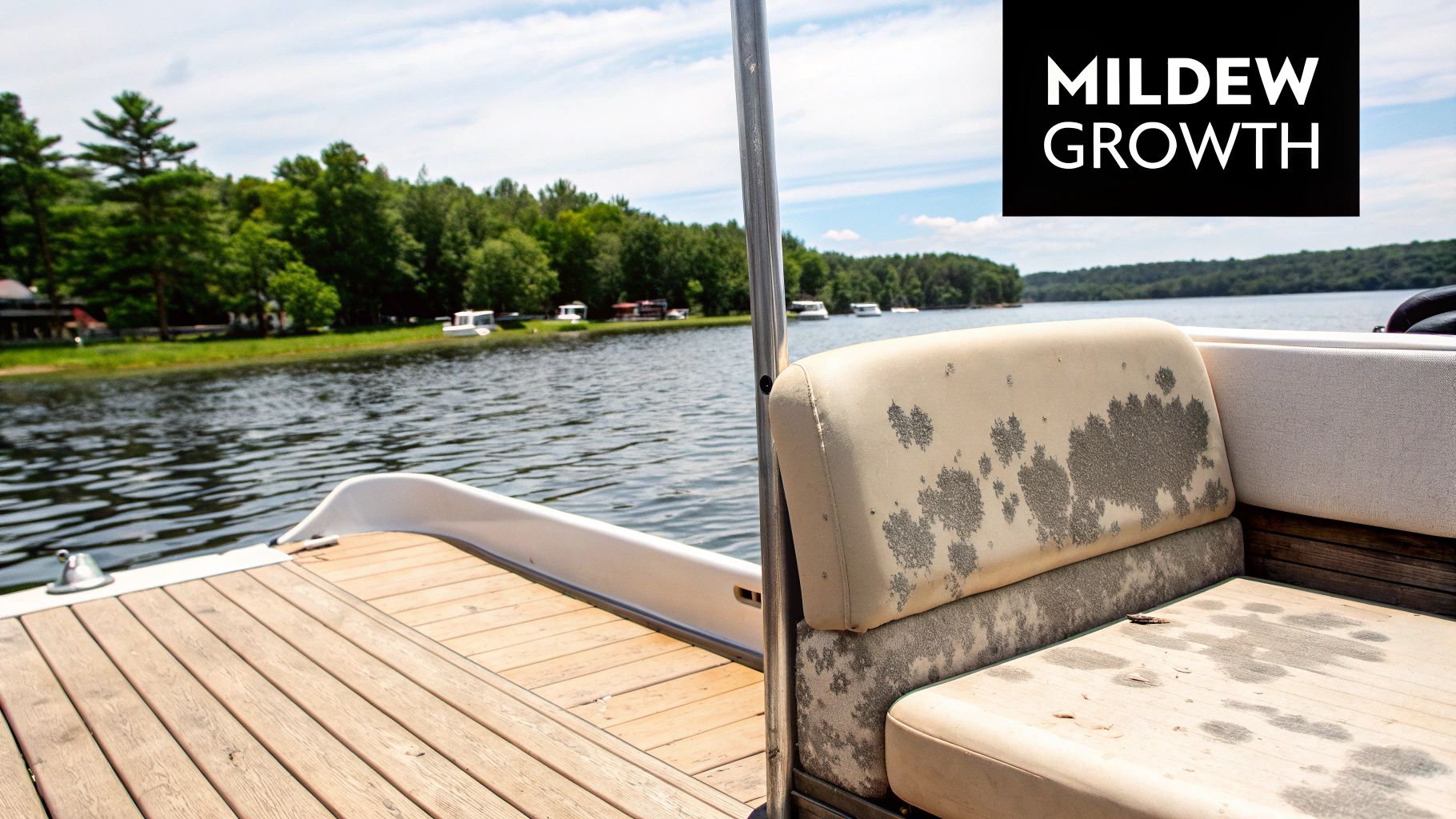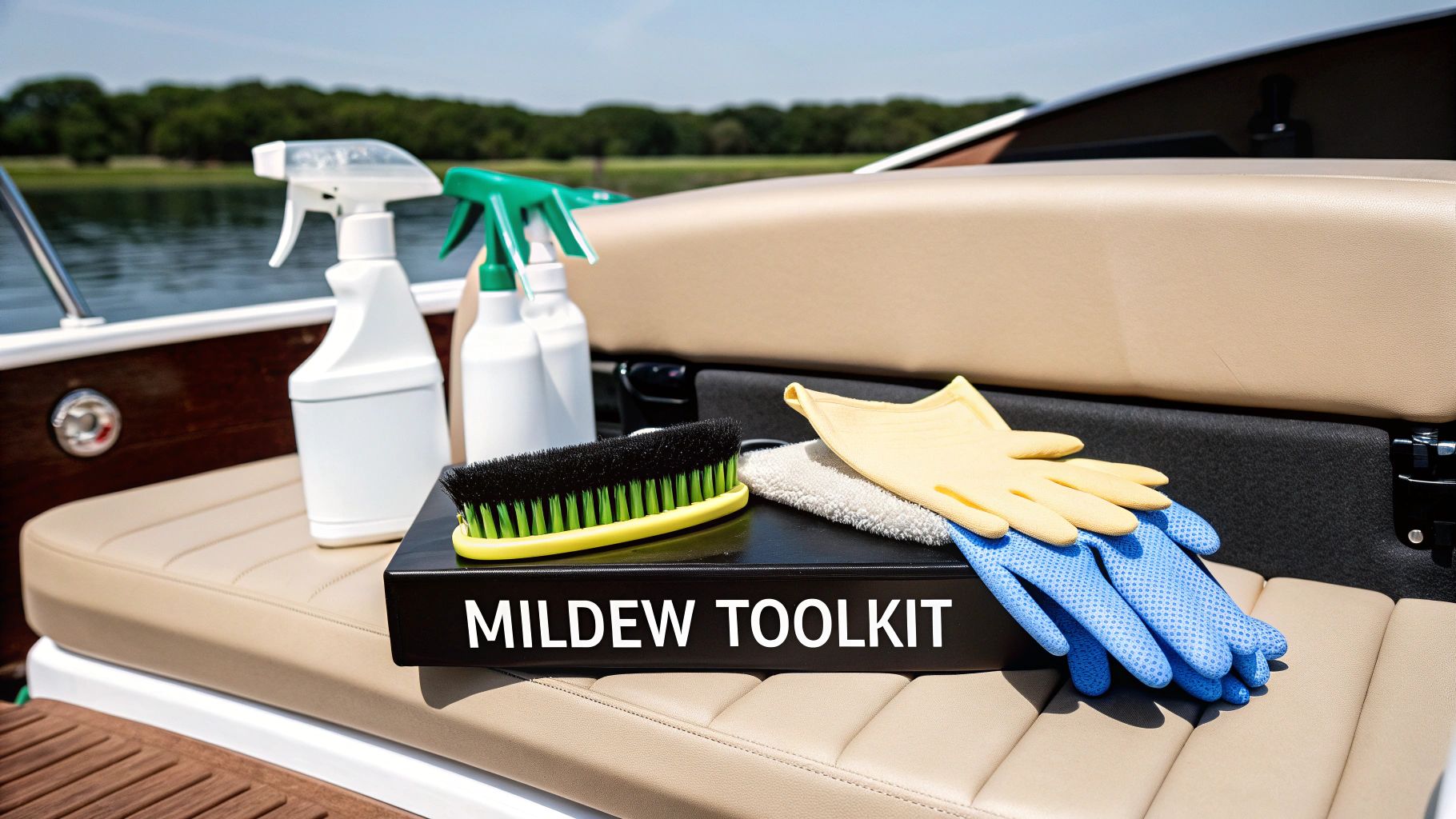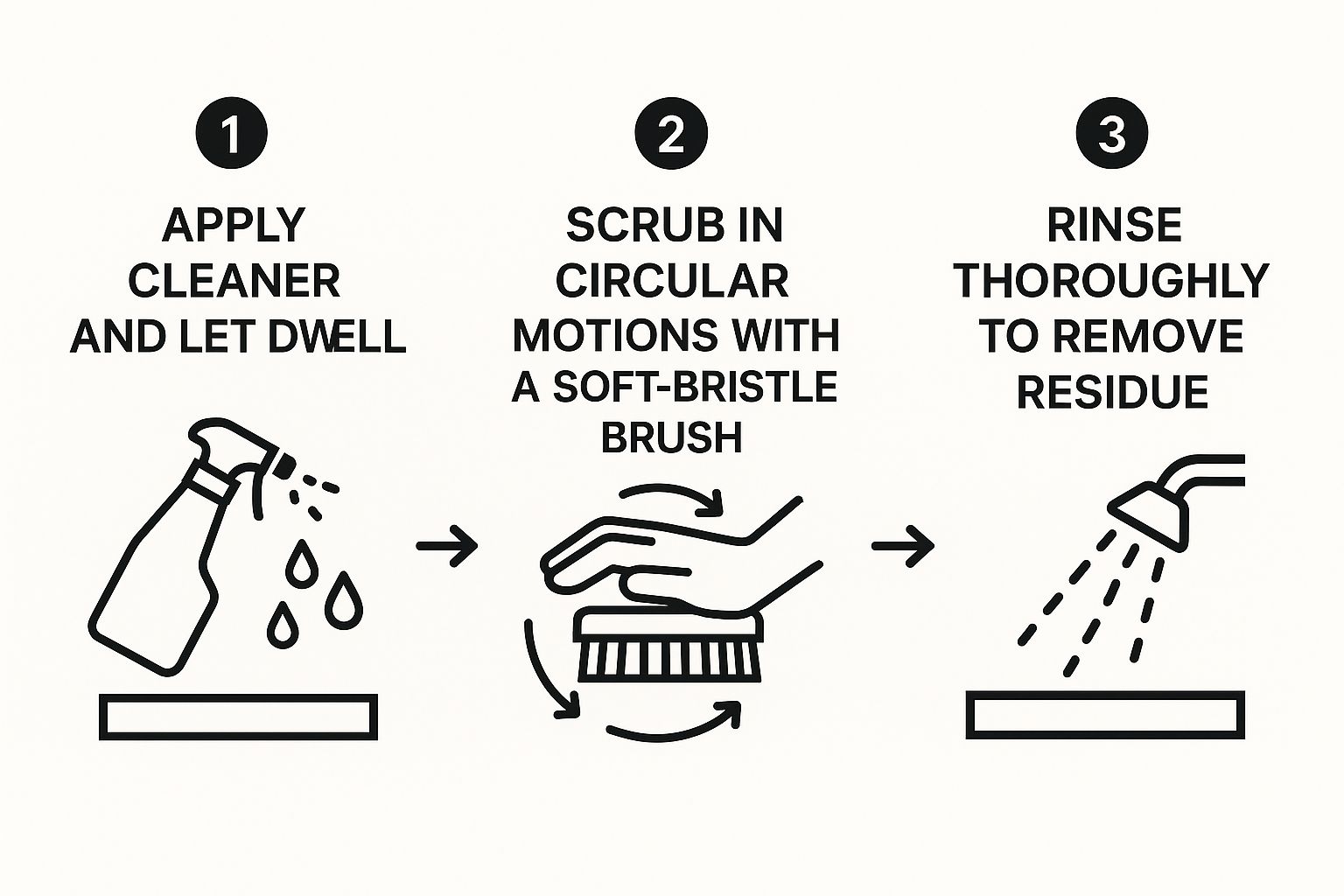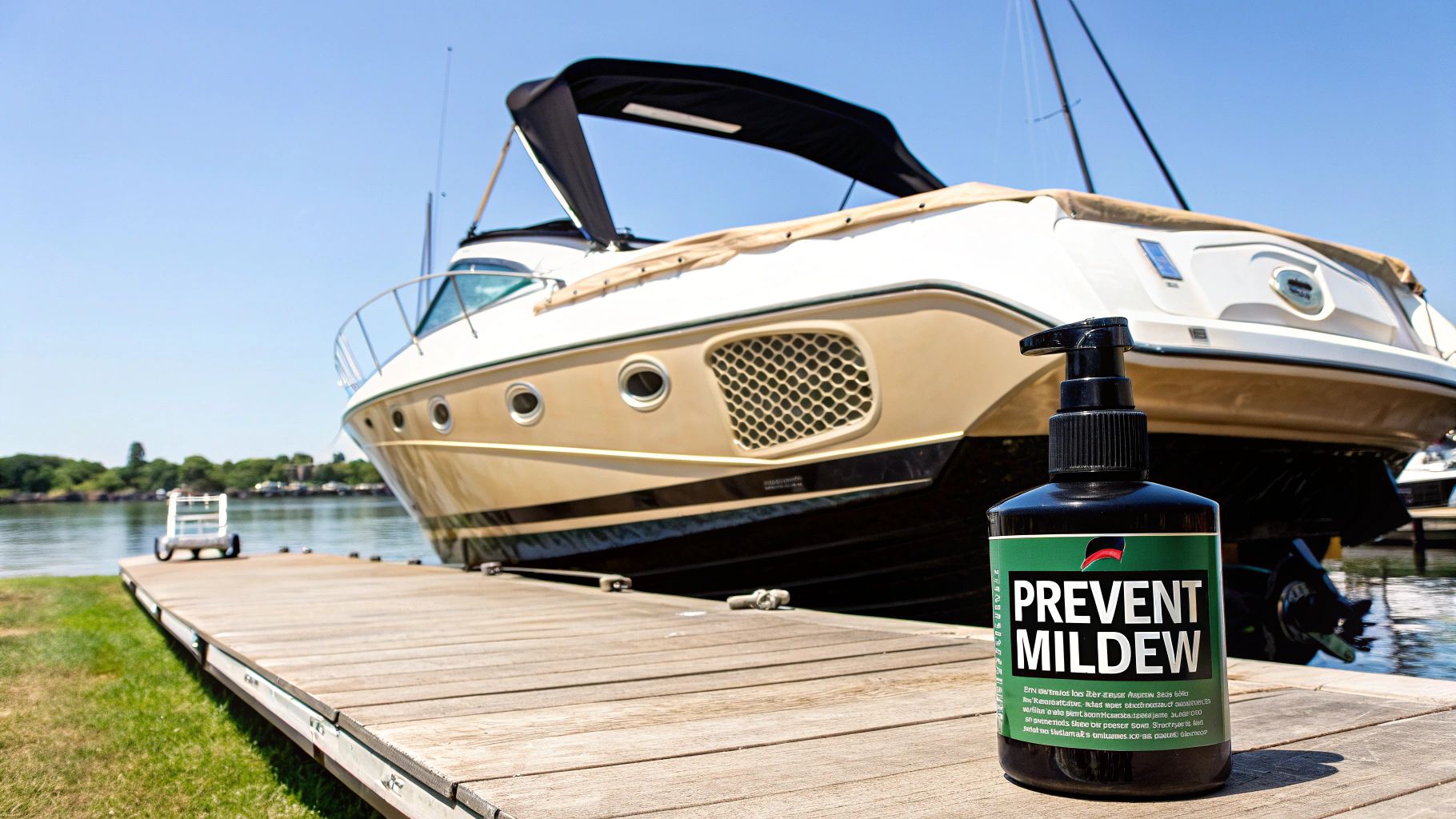Mildew Removal Boat Seats Guide
To get rid of mildew on your boat seats for good, you first have to understand what you're up against. It's not just a stain; it's a living fungus that thrives on a specific cocktail of moisture, warmth, and organic matter.
The secret isn't just scrubbing it away—it's about killing it at the source, rinsing away the evidence, and making sure the seats are bone dry to stop it from coming right back.
Why Mildew Loves Your Boat Seats

We’ve all been there. You pull back the boat cover after a few rainy days, excited for a day on the water, only to be greeted by ugly black and gray spots speckling your once-pristine vinyl. It's one of the most common and frustrating problems for any boat owner.
The truth is, the marine environment is a five-star resort for mildew. It’s a type of fungus that absolutely loves damp, warm, and stagnant conditions—basically, the exact environment under your boat cover.
Your boat seats aren't just an unfortunate victim; they're the perfect habitat. Think about it: they’re constantly getting wet from spray, rain, or damp towels and swimsuits. Throw in the heat from a sunny day getting trapped under a cover, and you've basically built a greenhouse for mildew to flourish.
The Perfect Recipe for Mildew
Mildew only needs a few things to take over your boat's upholstery. Getting a handle on these factors is your first real step toward effective mildew removal for boat seats and, even better, preventing it from ever coming back.
- Constant Moisture: Boats and water go hand-in-hand. From morning dew to water that pools in the seams after a swim, moisture is a constant battle.
- Lack of Airflow: As soon as you snap on that boat cover or close up the cabin, air circulation grinds to a halt. That trapped, humid air is exactly what mildew spores are waiting for.
- Organic Food Sources: Mildew needs to eat, and it’s not picky. Sunscreen, body oils, food crumbs, and even everyday dirt provide a buffet for it to grow and spread.
If you’re dealing with this, you’re not alone. A study from the Boat Owners Association of The United States (BoatUS) found that roughly 70% of boat owners tackle some kind of maintenance problem each year, with mildew being a top offender. You can read more about their findings on marine maintenance here.
Key Distinction: Mold vs. Mildew
People often use these terms interchangeably, but there's a difference. Mildew is usually a surface-level problem, appearing as powdery gray or white patches. Mold is the more sinister cousin—it's often slimy or fuzzy, can be black or green, and burrows deep into materials, sometimes reaching the foam cushions under the vinyl.
Knowing what causes the problem is half the battle. You're not just fighting the stains you can see; you're fighting the environment that creates them. Once you understand why mildew finds your boat seats so inviting, you can go beyond just cleaning and build a strategy to keep them looking sharp all season long.
Assembling Your Mildew Fighting Toolkit

Trying to tackle mildew without the right gear is like trying to bail out a boat with a teaspoon—it's just not going to work. Before you dive in, you need to build the right toolkit. Having everything ready to go ensures you can work efficiently and safely, getting the job done right the first time.
Taking a few minutes to gather your supplies is a crucial first step. It keeps you from having to stop mid-job to hunt for a brush or a clean towel, which can let cleaners dry on your vinyl before you have a chance to work them in.
Your Essential Cleaning Arsenal
Your choice of cleaner is probably the most important decision you'll make. For very light, brand-new spots, a simple solution of white vinegar and water can sometimes do the trick. But for anything more established, you absolutely need a dedicated, marine-grade cleaner. These formulas are made specifically to kill mildew spores without drying out or damaging delicate marine vinyl and stitching.
Here’s what your core toolkit should look like:
- A Quality Marine Mildew Stain Remover: Get a product proven to be safe for vinyl, rubber, and fiberglass, like Better Boat's Mildew Stain Remover.
- Soft-Bristle Brushes: This is key. Avoid stiff or abrasive brushes that can scratch the vinyl. Those tiny abrasions will just trap more dirt and moisture later on, making your problem worse. Having a couple of different sizes helps for getting into tight seams and corners.
- Microfiber Towels: These are non-negotiable. Their soft, absorbent fibers are perfect for lifting away cleaner residue and drying the seats thoroughly without leaving annoying lint behind.
- A Bucket of Clean Water: You'll want this handy for rinsing your brushes and cloths. It prevents you from just spreading grime from one spot to another.
"The biggest mistake I see boat owners make is using harsh household cleaners like straight bleach. It might remove the stain initially, but it compromises the vinyl's protective topcoat, leading to cracking and faster re-infestation down the road."
Safety Gear Is Not Optional
Whenever you’re working with cleaning agents, you have to protect yourself. Mildew spores can cause respiratory irritation, and the chemicals themselves can be tough on your skin and eyes.
Don’t even think about starting without these:
- Waterproof Gloves: Protect your hands from the cleaner and the mildew itself.
- Safety Glasses or Goggles: You only get one set of eyes. Shield them from any accidental splashes.
Having a complete set of the right tools makes the entire process go so much smoother. If you're looking to build out a more versatile collection of marine care gear, our guide to creating the ultimate boat cleaning kit is a fantastic place to start. It'll help you keep your entire vessel in prime condition.
A Practical Guide to Cleaning Your Boat Seats
Alright, you've got your supplies gathered, so let's get to the satisfying part: making that mildew disappear. Getting rid of mildew on boat seats isn't about brute force. Please, don't just start scrubbing until your arms feel like they're going to fall off. The real secret is using the right technique and letting your cleaner do the heavy lifting for you.
Our goal here is simple: kill the mildew spores at the root, lift the stains out of the vinyl, and then rinse it all away completely. Think of it as a tactical operation, not an all-out war. Each step sets up the next one for success.
Applying the Cleaner for Maximum Impact
First things first, grab your marine mildew remover—something like Better Boat's Mildew Stain Remover is perfect for this. Lightly spray it directly onto the mildew-affected spots. The key word here is lightly. A common mistake I see is people absolutely drenching their seats. All that does is waste product and create a soupy mess you have to deal with later.
Just apply enough to cover the visible mildew and a little bit of the area around it. Now for the most important part of this whole process: let it dwell. Seriously, walk away. Most quality marine cleaners need about 10-15 minutes to really work their magic, penetrating the vinyl and breaking down the mildew at its source. Be patient—this is where the battle is won.
The Art of Gentle Agitation
Once the cleaner has had a chance to sit and do its thing, it's time to gently persuade those stains to leave. Grab your soft-bristle brush and start scrubbing the areas in light, overlapping circles. This motion is great for working the dislodged mildew out of the vinyl's texture without gouging or scratching the material.
If you hit a particularly stubborn spot, resist the urge to just push harder. Instead, give it another quick, light mist of cleaner and go over it again with the same gentle circular motion. The product is doing the work, not your muscles. This methodical approach is what separates a clean seat from a damaged one.
This whole process really boils down to three simple stages. This infographic gives a great visual of the core actions.

As you can see, it’s all about a patient application, gentle agitation, and a thorough rinse. Every single step is critical.
The Most Overlooked Step: The Rinse
Don't rush this part! So many boat owners get excited seeing the stains disappear and do a quick splash-and-dash rinse, but this is probably the most critical step for keeping mildew from coming right back. Any cleaner residue left behind becomes a sticky magnet for dirt, grime, and moisture—basically a welcome mat for new mildew.
Use a hose on a gentle setting or a bucket of fresh, clean water with a stack of microfiber cloths. You need to wipe down every square inch that you treated. Rinse your cloth out frequently in the clean water. You'll know you're finished when you can run your hand over the vinyl and it feels smooth, not slick or soapy at all.
Pro Tip: After the final rinse, grab some dry microfiber towels and blot up as much water as you can. Then, if possible, let the seats air dry completely in the sun. The UV rays act as a final, natural sanitizer, and making sure the seats are bone dry is your absolute best defense against mildew making a quick comeback.
Once they're dry, your seats are officially clean and ready for a protective treatment. While we're focused on boat seats here, the same principles of thorough cleaning apply to all your marine gear.
If you want to dive deeper into maintaining your other equipment, this guide on how to clean snorkel gear has some great, practical tips. Keeping everything clean doesn't just look good—it makes it all last longer.
Choosing the Right Mildew Removal Method
When you’re staring down mildew on your boat seats, the first question is always, "What should I use to get rid of this?" It’s a huge decision. The right cleaner will bring your seats back to life, but the wrong one can flat-out ruin your vinyl.
You’re basically looking at two options: dedicated marine cleaners or homemade DIY solutions. Both have their place, and knowing when to reach for which is the key to successfully tackling mildew removal for boat seats. The choice really boils down to how bad the mildew is and what kind of material you’re cleaning.
When to Use a Dedicated Marine Cleaner
If you're dealing with anything more than a few faint, brand-new spots, a specialized marine cleaner is almost always your best bet. Picture this: you pull the cover off after a few rainy weeks and find dark, set-in stains that have clearly been there for a while. This is no time for a gentle, homemade remedy.
Marine-grade mildew removers are engineered for this exact scenario. They’re packed with powerful agents that kill mildew spores at the root, plus surfactants that lift the ugly stains out of the vinyl’s texture. Most importantly, they’re designed to do all this without stripping the essential plasticizers from the vinyl that keep it soft and prevent cracking.
Grabbing a product like Better Boat’s Mildew Stain Remover is a smart move in these situations:
- Stubborn, Set-In Stains: If mildew has had time to settle in, it's burrowed into the top layer of the vinyl. You need some real chemical muscle to break it down.
- Premium or Colored Vinyl: High-end marine vinyl has protective topcoats. Harsh, non-marine chemicals can eat right through that layer, leading to fading and cracking.
- Recurring Mildew Problems: See mildew popping up in the same spots over and over? That means you’re just cleaning the surface stain, not killing the spores. A dedicated cleaner eradicates the source.
For a deeper look at the top products out there, our guide on the best cleaners for boat seats breaks down the options to help you choose the right one for your boat.
When a DIY Solution Makes Sense
On the other hand, you don’t always need to bring out the heavy artillery. For light-duty work and prevention, a homemade solution can be perfect. A simple mix of 50/50 white vinegar and water is surprisingly effective. Vinegar is acidic enough to kill early-stage mildew spores on contact.
A simple vinegar solution is your best friend for routine maintenance. A quick wipe-down every few weeks can prevent mildew from ever getting a foothold, saving you from a much bigger cleaning job later.
This approach works great for:
- Routine Preventative Cleaning: Wiping down seats with a vinegar solution after a weekend on the water is a fantastic habit. It removes the sunscreen, sweat, and grime that mildew loves to feed on.
- Very Light, New Mildew: If you catch a few tiny spots just as they're forming, a DIY spray is often all you need to knock them out without resorting to stronger chemicals.
- Sensitive or Older Upholstery: Got older vinyl that might be a bit fragile? It's always smart to start with the mildest effective solution to avoid causing any unintentional damage.
Mildew Cleaner Comparison for Boat Seats
Deciding between a professional product and a home remedy can be tough. This table breaks down the pros and cons of the most common options to help you make the right call for your boat's vinyl.
| Cleaning Method | Effectiveness | Vinyl Safety | Best For |
|---|---|---|---|
| Marine Mildew Remover | High - Kills spores & removes deep stains. | Excellent - Formulated for marine vinyl. | Stubborn, set-in stains and recurring mildew problems. |
| White Vinegar & Water | Moderate - Kills new spores, light stains. | Good - Generally safe, but can dry out old vinyl. | Routine prevention and very light, new mildew spots. |
| Bleach Solution | High - Very effective at killing mildew. | Poor - Not recommended. Damages vinyl, thread, and colors. | Emergency use only, on non-critical surfaces (if at all). |
| Magic Eraser | Moderate - Removes surface stains. | Poor - Highly abrasive; can strip vinyl's topcoat. | Small, non-textured areas, with extreme caution. |
Ultimately, there's no single "best" method—it's about having the right tool for the job. Take a good look at the problem, consider the value of your upholstery, and pick the solution that makes the most sense.
Getting Ahead of Mildew Before It Starts

Here's the real secret to winning the war against mildew: it’s not about how well you clean, it's about how well you prevent. Cleaning is just a reaction to a problem that's already taken hold. A solid prevention strategy stops that problem from ever starting, saving you countless hours of scrubbing down the line.
The simple habits you build into your boating routine are your most powerful defense. If you focus on keeping things dry, letting the air move, and protecting your vinyl, you can turn your boat seats from a mildew magnet into a place where fungus just can't survive. It's the small efforts that make the biggest difference.
Let the Air Flow
Mildew absolutely loves stagnant, humid air—which is exactly what gets trapped under a boat cover or inside a stuffy cabin. Breaking that cycle should be your top priority. You've got to get the air moving, even when the boat is just sitting at the dock.
This doesn't need to be some complicated setup. A few simple tricks can dramatically improve ventilation and get rid of the damp, still conditions mildew needs to grow.
- Install Vents: Pop a couple of simple boat cover vents in. They're cheap and a great way to let trapped moisture and hot air escape.
- Use Small Fans: A little solar-powered or battery-operated fan inside the cabin can keep air circulating, stopping moisture from settling on your seats.
- Prop Open Cushions: When you're storing the boat, just prop your seat cushions up a bit. Even a small gap lets air flow underneath and all around them, which is huge for preventing trapped moisture.
Master the Post-Trip Wipe-Down
If you adopt only one new habit, make it this one: a quick wipe-down after every single trip. It takes less than five minutes, but it gets rid of all the "food" that mildew needs to grow—things like sunscreen, sweat, spilled drinks, and salt spray create a perfect buffet for spores.
Just keep a spray bottle of diluted marine vinyl cleaner (or even a 50/50 water-and-vinegar mix) and a few microfiber towels on board. A quick spray and wipe of all your vinyl before you throw the cover on is an absolute game-changer.
This simple ritual is the core of successful long-term mildew removal for boat seats because it stops the problem before it can even begin. For more practical know-how, you can learn some expert tips from a Dive Boat Captain on maintaining a vessel.
A dry boat is a happy boat. Never, ever put a boat cover on a wet boat. Trapping moisture underneath is like rolling out the welcome mat for mildew and can cause widespread issues in just a few days.
Create a Protective Barrier
Okay, so your seats are clean and completely dry. The final step is to protect them. A quality marine vinyl protectant, like our Better Boat Vinyl Protectant, does way more than just add a nice shine. It actually creates an invisible barrier on the vinyl surface.
This barrier is a two-for-one deal. First, it helps repel water, making it bead up and roll right off instead of soaking in. Second, it has UV inhibitors that shield the vinyl from sun damage, which can weaken the material and make it easier for mildew to penetrate.
For an extra layer of moisture control, especially during storage, our guide on boat dehumidifiers has some great solutions. Reapplying a protectant every 4-6 weeks during the boating season keeps that barrier strong, ensuring your seats stay resilient and clean.
Common Questions on Boat Seat Mildew Removal
Even when you think you have your cleaning game plan dialed in, a few questions always seem to surface. When it comes to tackling mildew on boat seats, getting the right answers can be the difference between a pristine finish and a costly mistake. Let’s clear up some of the most common things we hear from fellow boaters.
Can I Use Household Bleach on My Vinyl Seats?
This is the big one, and the short answer is a hard no. It's tempting, I get it. Bleach is a powerful killer of mildew, but it’s far too harsh for marine vinyl and ends up doing a lot more harm than good.
Bleach attacks the essential plasticizers in the vinyl—the very compounds that keep it soft and flexible. Over time, this exposure leaves the material brittle, which is a fast track to cracking, fading, and even damaged stitching. It's always a smarter, safer bet to stick with a dedicated marine cleaner that’s formulated to be tough on mildew but gentle on your seats.
How Often Should I Clean to Prevent Mildew?
Consistency is king here. During peak boating season, especially if you're in a humid climate, getting into the habit of a quick wipe-down every few weeks makes a world of difference. We're not talking a full deep scrub, just a simple clean with a mild marine soap or even a 50/50 vinegar-water solution to clear away the dirt and oils that mildew loves to feed on.
But the second you spot even a tiny speck of mildew, it’s go-time. Jump on it immediately with a targeted cleaning. A small spot is easy to handle; a full-blown infestation is a whole different battle.
What Is the Difference Between Mold and Mildew?
While they're related, they show up differently and require a slightly different mindset. Mildew is what you’ll usually find on marine vinyl. It’s a surface-level fungus that typically looks like gray or white powdery patches. Annoying, but manageable.
Mold, on the other hand, is its more aggressive cousin. It often appears fuzzy or slimy and can be black, green, or other dark colors. The real trouble with mold is its ability to penetrate deeper into the vinyl and, worse, into the foam cushion underneath.
While the initial cleaning approach is similar, a serious mold problem might mean the cushion itself needs professional help or even replacement to truly get rid of all the spores.
For every challenge you face out on the water, Better Boat has a solution designed by boaters, for boaters. Our Mildew Stain Remover is specifically formulated to knock out tough stains safely and effectively, bringing your seats back to life without damaging the vinyl. Keep your boat looking its best all season long and check out our full range of cleaning and care products.


